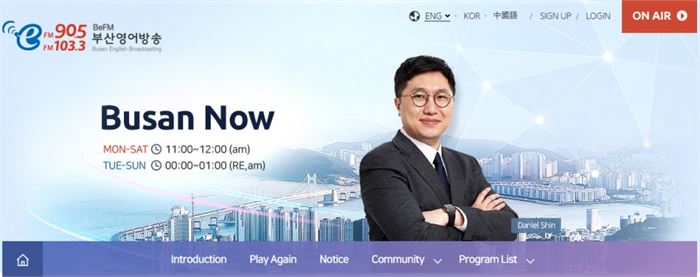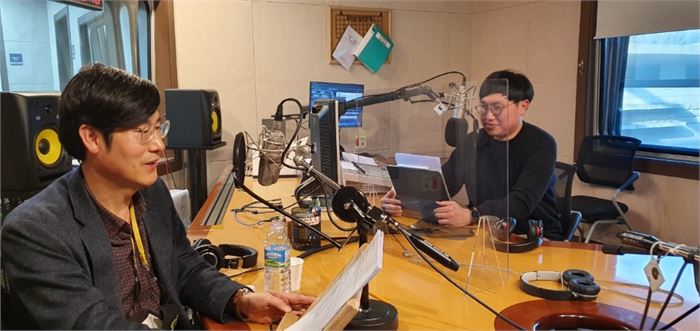인저리타임은 김해창 교수가 고정출연하는 부산영어방송 프로그램 「Busan Now」의 'Glocal Busan' 코너를 연재한다. 이 코너에서 김 교수는 자신의 저서 『창조도시 부산, 소프트전략을 말한다』(인타임)를 바탕으로 창조도시 글로컬 부산을 만들기 위한 소프트전략을 영어로 소개한다. '창조도시 부산, 소프트전략'은 2018년 12월부터 2020년 5월까지 1년 6개월에 걸쳐 본 사이트에 게재됐으며, 인저리타임의 자매 출판사인 인타임이 2020년 9월 단행본으로 펴내 지역사회에 신선한 바람을 불러일으키고 있다.
 다시 듣기 ☞ https://www.befm.or.kr/aod/playagain.php?playcode=MjY1ODk=
다시 듣기 ☞ https://www.befm.or.kr/aod/playagain.php?playcode=MjY1ODk=
■5회(2020년 11월 30일) 부산 재래시장을 ‘친절공화국’으로 만들자
소셜 디자이너, 경성대 환경공학과 김해창 교수 나오셨습니다.
안녕하세요.
Kim Hae-chang, a social designer and professor of environmental engineering at Kyungsung University is here.
Hellow!
▶오늘은 어떤 주제로 얘기 나눠볼까요?
"요즘 국내외 할 것 없이 대형마트의 등장으로 지역 재래시장의 상권이 거의 죽어가고 있지 않아요? 이런 가운데 창조적 아이디어를 바탕으로 새롭게 재래시장의 변신을 도모할 수 없을까 하는 고민에서 나온 것입니다. 재래시장에 아이디어를 더해 좀 더 특색있고 매력적인 문화시장으로 만들 수 없을까 하는 제안입니다. 국내외 재래시장의 변신 성공사례를 소개하고 싶습니다."
▶What topic should we talk about today?
"Aren't the commercial districts of the local traditional markets almost dying with the advent of large discount stores at home and abroad these days?
In the midst of this, we are worried about whether we can make a new transformation of traditional markets based on creative ideas. It is a suggestion that we can make a more distinctive and attractive cultural market by adding ideas to traditional markets. I would like to introduce successful transformation of domestic and foreign traditional markets."
▶말씀하신 바와 같이 재래시장의 대변신을 보여주는 모델이 되는 시장이 있으면 소개해주시죠?
"네. 우선 일본 센다이시의 ‘아라마치공화국’ 만들기 사례를 소개합니다. 미야기현 센다이시의 아라마치지구의 상가번영회가 1993년 재래시장인 아라마치시장을 아라마치공화국으로 선포를 해 관심을 끌었지요. 문방구점을 경영하던 주인인 이즈모 고코로씨가 번영회장이 되면서 ‘행복한 상점가 만들기’에 도전한 것이죠."
▶As you told, if there is a market that shows the transformation of traditional markets, can you introduce it?
"Yes. First of all, let me introduce you to the case of making 'Aramachi Republic' in Sendai, Japan. The shopping center of the Aramachi district in Sendai, Miyagi Prefecture, declared the traditional Aramachi Market to the ‘Republic of Aramachi’ in 1993.
Izumo Gokoro, who was the owner of the stationery store, became the chairman of the Prosperity Association and challenged to create a "happy shopping district."
▶구체적으로 아라마치공화국 만들기라는 게 어떻게 진행됐나요?
"우선 아라마치공화국은 상인헌장을 만들었습니다. 그 내용을 보면 ‘우리들은 아라마치상인임을 자랑스럽게 생각하며 책임감을 느낍니다. 문화의 향기가 넘치는 마을을 만드는 데 앞장서겠습니다. 아라마치공화국은 노인들에게 대중교통이용권 및 서비스권을 드리고 담배를 함부로 버린 사람들에겐 벌금을 매기고 점포의 셔터에 시를 붙이고 노인에게 복지도시락을 배달한다는 등 다양한 사업을 펼쳤습니다. 그래서 전국적으로 언론의 주목을 받았죠. 그리고 매년 아라마치공화국은 외부 전문가와 고객들의 의견을 적극 수용했어요. 예를 들면 ’우주인 아라마치 탐험대‘라는 프로그램을 가동해 국내외 고객들이 재래시장을 찾아 외부인의 시각, 즉 우주인의 눈으로 재래시장의 발전을 위한 새로운 제안을 받고, 그것을 반영해 새롭게 시장이 모습을 바꿔놓기 때문에 지금도 인기있는 재래시장으로 알려져 있죠."
 부산영어방송 BUSAN NOW의 '글로컬 부산' 진행자 다니엘 신(오른쪽)과 출연자 김해창 교수.
부산영어방송 BUSAN NOW의 '글로컬 부산' 진행자 다니엘 신(오른쪽)과 출연자 김해창 교수.
▶Specifically, how did the creation of the Aramachi Republic proceed?
"First of all, the Republic of Aramachi made the Merchant Charter. It says, 'We are proud to be Aramachi merchants and feel responsible. I will take the lead in creating a village full of culture. The Republic of Aramachi will carry out various projects, including giving senior citizens public transportation passes and service rights, imposing fines on those who throw away cigarettes, attaching poems to the shutters of stores and delivering welfare services to senior citizens.
That's why it has attracted media attention all over the country. And every year, the Republic of Aramachi actively accepted the opinions of outside experts and customers.
For example, a program called “Aramachi Expedition for Spaceman” was launched, which attracts domestic and foreign customers to the Aramachi Market and receives new proposals for the development of the traditional market through their eyes, that is, the eyes of outsiders. And reflecting those opinions, They are changing the shape of the market."
▶네 발상이 재미있군요. 우리 국내에서 재래시장을 활성화한 사례 중에 성공사례가 있으면 소개해주셔도 좋겠네요.
"우리나라에서도 지역마다 재래시장 활성화를 위한 노력들이 있는데요. 그 중 하나로 서울 중랑구 망우동의 우림시장의 사례를 소개드리겠습니다. 우림시장은 ’소가 숲을 이루고 있는 시장‘이란 뜻인데 예전에 소시장에 가던 소장수들이 잠시 머물던 재래시장이어서 그런 이름이 붙었다고 합니다. 우림시장은 지금도 귀여운 소를 시장의 마스코트로 사용하고 있지요."
▶Yes, your idea is interesting. If you have any success stories in activating traditional markets in Korea, please introduce them.
"In our country, there are efforts to revitalize traditional markets in various regions. One of them is Woorim Market in Mangwoo-dong, Jungnang-gu, Seoul.
Woorim Market means "a market where cows form a forest." It is said to be named because it was a snalll market where the cattle sellers stayed for a while to take a break on the way to sell cattle at the big market in Seoul. Woorim Market still uses cute cows as its mascot."
▶우림시장이 어떻게 변했는지 궁금해지네요?
"서울 망우동 우림시장은 2011년에 재래시장 활성화를 위해 ‘춤추는 황금소’ 프로젝트를 시작했습니다. 시장 속에 ‘춤추는 황금소’ 사무실을 만들고 주민과 상인들이 아마추어극단을 만들어 직접 공연을 한 것이죠. 40여년의 우림시장의 역사 속 상인들의 삶의 애환을 담은 공연으로 재미와 감동을 선사했죠. 재미있는 것은 관람할 때 별도 비용 없이 쌀이나 라면을 가져와 기부하면 공연 후에 어려운 이웃에게 전달한답니다. 이 밖에도 ‘다문화 요리체험’ ‘시장통학교’ ‘추억의 영화관’ ‘등산객 주막’ 등을 열어 지역의 명물시장으로 거듭나고 있지요."
▶I wonder how the Woorim Market has changed?
"Woorim Market in Mangwoo-dong, Seoul, launched the 'Dancing Golden Cow' project in 2011 to revitalize traditional market.
They created an office called "Dancing Golden Cow" in the market, and residents and merchants created amateur theater troupes and performed themselves.
It was a performance about the joys and sorrows of merchants in the history of Woorim Market for more than 40 years. The interesting thing is that when the audience donate rice or ramen at no extra charge, the market theater related deliver it to their neighbors in need after the performance. In addition, it has been reborn as a local specialty market by opening 'multicultural cooking experience', 'market school', 'screening of memories' and so on."
▶우리 부산의 재래시장이 좀 더 활성화되기 위해서는 어떤 것들이 필요할까요?
"네. 저는 우선 지자체와 상가번영회가 뜻을 모아 현재의 지역 재래시장이 갖고 있는 문제가 뭔지를 철저히 분석하고 국내외 재래시장 활성화 사례를 벤치마팅하는 게 중요하다고 생각합니다. 그리고 무엇보다 상인들이 친절하고, 정감이 가는 시장을 만들어가겠다는 결의를 다지고, 자신들이 지금까지 살아온 삶이나 문화를 시장을 찾는 사람들에게 새롭게 보여주고 이를 문화적으로 프로그램화하는 것도 필요하지요. 특히 요즘 젊은 예술가들을 불러들여 이들과 함께 재래시장의 이야기거리, 볼 거리를 만들어내는 스토리텔링을 개발할 필요가 있다고 생각합니다. 시청이나 구청은 이들 재래시장에 대해 시설 개선 뿐만 아니라 이러한 스토리텔링사업을 적극 지원해주면 좋겠습니다."
▶What do we need to boost our traditional markets in Busan?
"Yes. First of all, I think it is important for the local government and the shopping street prosperity association members to work together to thoroughly analyze the problems of the current local traditional market and benchmark cases of the revitalization of traditional markets at home and abroad. And most of all, it's necessary for merchants to be determined to create a kind, friendly market, to show the lives and cultures that they've lived through to the market, and to program them culturally.
In particular, I think it is necessary to bring in young artists these days and develop storytelling that creates stories and attractions in traditional markets. I hope that the local administration concerned will not only try to improve the facilities of these traditional markets but also actively support these storytelling projects."
<정리 = 조송현>